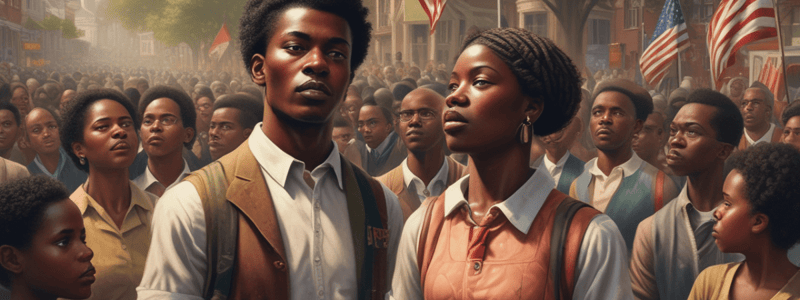Podcast
Questions and Answers
When were Jim Crow laws instituted in the Southern United States?
When were Jim Crow laws instituted in the Southern United States?
- Before the Civil War
- Shortly after the Civil War (correct)
- During the Civil Rights protests of the 1960s
- After the Brown v. Board of Education ruling
What was the legal basis for racial segregation in public facilities according to the U.S. Supreme Court in Plessy v. Ferguson (1896)?
What was the legal basis for racial segregation in public facilities according to the U.S. Supreme Court in Plessy v. Ferguson (1896)?
- Separate but equal facilities for different races (correct)
- Full integration of African Americans in all public spaces
- Equal rights and opportunities for all races
- Abolishment of segregation laws
Which event contributed to the declaration that segregation in state-funded public schools was unconstitutional?
Which event contributed to the declaration that segregation in state-funded public schools was unconstitutional?
- Plessy v. Ferguson case
- Civil Rights Act of 1964
- Jim Crow laws enactment
- Brown v. Board of Education ruling (correct)
How did the Jim Crow laws impact African Americans' access to education in the Southern United States?
How did the Jim Crow laws impact African Americans' access to education in the Southern United States?
What legislation ultimately led to the end of legalized racial suppression against Black Americans in the United States?
What legislation ultimately led to the end of legalized racial suppression against Black Americans in the United States?
Flashcards are hidden until you start studying
Study Notes
- Jim Crow laws were state and local statutes in the Southern United States that legalized racial segregation, marginalizing African Americans by suppressing their rights, limiting job opportunities, and restricting access to education.
- Instituted shortly after the Civil War, Jim Crow laws lasted until the civil rights protests and federal legislation of the 1960s, perpetuating economic, educational, and social disadvantages for African Americans in the South.
- The U.S. Supreme Court upheld racial segregation in public facilities with the "separate but equal" doctrine in the 1896 case of Plessy v. Ferguson, leading to inferior and underfunded facilities for African Americans compared to whites.
- Despite the landmark 1954 Brown v. Board of Education ruling declaring segregation in state-funded public schools unconstitutional, many Southern states resisted integration for years, facing backlash from white southerners.
- The Jim Crow laws were ultimately overruled by the Civil Rights Act of 1964 and the Voting Rights Act of 1965, marking the end of legalized racial suppression against Black Americans in the United States.
Studying That Suits You
Use AI to generate personalized quizzes and flashcards to suit your learning preferences.




